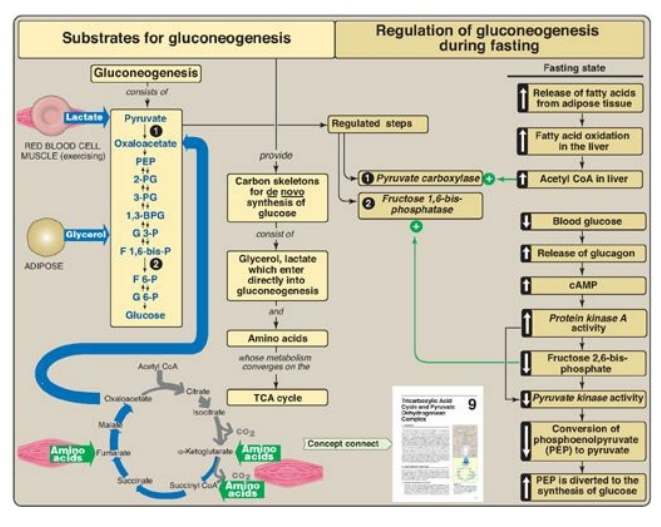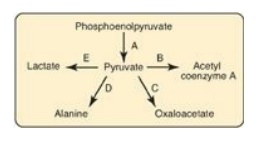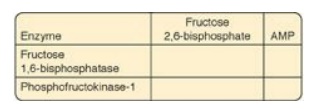Chapter Summary, Study Questions - Gluconeogenesis
| Home | | Biochemistry |Chapter: Biochemistry : Gluconeogenesis
Gluconeogenic precursors include the intermediates of glycolysis and the tricarboxylic acid cycle, glycerol released during the hydrolysis of triacylglycerols in adipose tissue, lactate released by cells that lack mitochondria and by exercising skeletal muscle, and α-keto acids derived from the metabolism of glucogenic amino acids.
CHAPTER SUMMARY
Gluconeogenic
precursors include the intermediates of glycolysis and the tricarboxylic acid
cycle, glycerol released during the hydrolysis of triacylglycerols in adipose
tissue, lactate released by cells that lack mitochondria and by exercising
skeletal muscle, and α-keto acids derived from the metabolism of glucogenic
amino acids (Figure 10.10). Seven of the reactions of glycolysis are reversible
and are used for gluconeogenesis in the liver and kidneys. Three reactions are
physiologically irreversible and must be circumvented. These reactions are
catalyzed by the glycolytic enzymes pyruvate kinase, phosphofructokinase, and hexokinase.
Pyruvate is converted to oxaloacetate and then to phosphoenolpyruvate (PEP) by
pyruvate carboxylase and PEP-carboxykinase. The carboxylase requires biotin and
ATP and is allosterically activated by acetyl coenzyme A. PEP-carboxykinase
requires GTP. The transcription of its gene is increased by glucagon and the
glucocorticoids and decreased by insulin. Fructose 1,6-bisphosphate is
converted to fructose 6-phosphate by fructose 1,6-bisphosphatase. This enzyme
is inhibited by elevated levels of AMP and activated when ATP levels are
elevated. The enzyme is also inhibited by fructose 2,6-bisphosphate, the
primary allosteric activator of glycolysis. Glucose 6-phosphate is converted to
glucose by glucose 6-phosphatase. This enzyme of the endoplasmic reticular
membrane is required for the final step in gluconeogenesis as well as hepatic
and renal glycogen degradation. Its deficiency results in severe, fasting
hypoglycemia.

Figure 10.10 Key concept map
for gluconeogenesis. TCA = tricarboxylic acid. CoA = coenzyme A; cAMP = cyclic
adenosine monophosphate; P = phosphate; PG = phosphoglycerate; BPG =
bisphosphoglycerate.
Study Questions
Choose the ONE best answer.
10.1 Which one of the following statements
concerning gluconeogenesis is correct?
A. It is an
energy-producing (exergonic) process.
B. It is important in maintaining blood glucose
during a fast.
C. It is inhibited by a
fall in the insulin-to-glucagon ratio.
D. It occurs in the
cytosol of muscle cells.
E. It uses carbon
skeletons provided by fatty acid degradation.
Correct answer = B. During a fast, glycogen stores are
depleted, and gluconeogenesis maintains blood glucose. Gluconeogenesis is an
energy-requiring (endergonic) pathway (both ATP and GTP get hydrolyzed) that
occurs in liver, with kidney becoming a major glucose-producing organ in
prolonged fasting. It utilizes both mitochondrial and cytosolic enzymes.
Gluconeogenesis is stimulated by a fall in the insulin/glucagon ratio. Fatty
acid degradation yields acetyl coenzyme A (CoA), which cannot be converted to
glucose. This is because there is no net gain of carbons from acetyl CoA in the
tricarboxylic acid cycle, and the pyruvate dehydrogenase reaction is
physiologically irreversible. It is the carbon skeletons of most amino acids
that are gluconeogenic.
10.2 Which reaction in the diagram below would be
inhibited in the presence of large amounts of avidin, an egg white protein that
binds and sequesters biotin?

Correct answer = C. Pyruvate is carboxylated to
oxaloacetate by pyruvate carboxylase, a biotin-requiring enzyme. B (PDH
complex) requires thiamine pyrophosphate, lipoic acid, FAD, coenzyme A, NAD; D (transaminase)
requires pyridoxal phosphate; E (lactate dehydrogenase) requires NADH.
10.3 Which one of the following reactions is unique
to gluconeogenesis?
A.
1,3-Bisphosphoglycerate → 3-phosphoglycerate
B. Lactate → pyruvate
C. Oxaloacetate → phosphoenolpyruvate
D. Phosphoenolpyruvate
→ pyruvate
Correct answer = C. The other reactions are common to
both gluconeogenesis and glycolysis.
10.4 Use the chart below to show the effect of
adenosine monophosphate (AMP) and fructose 2,6-bisphosphate on the listed
enzymes of gluconeogenesis and glycolysis.

Both fructose
2,6-bisphosphate and adenosine monophosphate downregulate gluconeogenesis
through inhibition of fructose 1,6-bisphosphatase and upregulate glycolysis
through activation of phosphofructokinase-1. This results in reciprocal
regulation of the two pathways.
10.5 The metabolism of ethanol by alcohol
dehydrogenase produces reduced nicotinamide adenine dinucleotide (NADH). What
effect is the change in the NAD+/NADH ratio expected to have on
gluconeogenesis? Explain.
The increase in NADH as
ethanol is oxidized will decrease the availability of oxaloacetate (OAA)
because the reversible oxidation of malate to OAA by malate dehydrogenase of
the tricarboxylic acid cycle is driven in the reverse direction by the high
availability of NADH. Additionally, the reversible reduction of pyruvate to
lactate by lactate dehydrogenase of glycolysis is driven in the forward
direction by NADH. Thus, two important gluconeogenic substrates, OAA and
pyruvate, are decreased as a result of the increase in NADH during ethanol
metabolism. This results in a decrease in gluconeogenesis.
10.6 Given that acetyl coenzyme A cannot be a
substrate for gluconeogenesis, why is its production in fatty acid oxidation
essential for gluconeogenesis?
Acetyl coenzyme A
inhibits the pyruvate dehydrogenase complex and activates pyruvate carboxylase,
pushing pyruvate to gluconeogenesis and away from oxidation.
Related Topics
